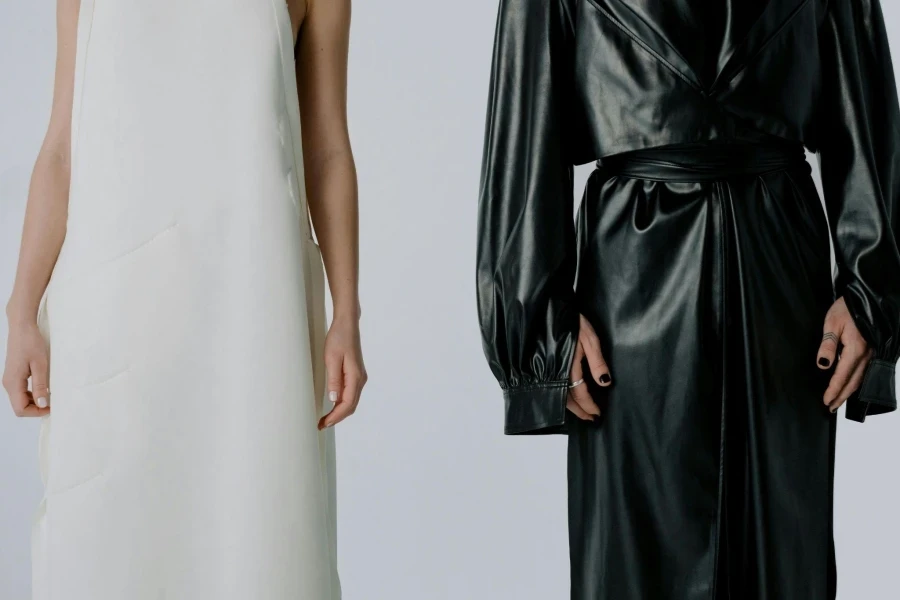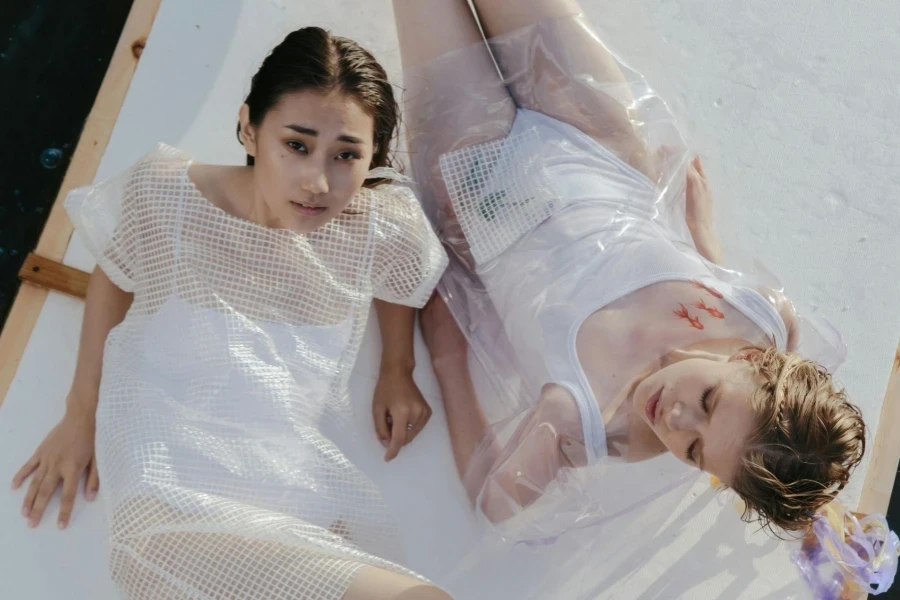As we look ahead to Spring/Summer 2025, the active materials landscape is poised for a remarkable transformation. This season’s innovations reflect a deep commitment to sustainability, performance, and adaptability in an era of unprecedented global change. From bio-synthetic breakthroughs to climate-adaptive solutions, the industry is embracing a new wave of creativity and responsibility. Tactile surfaces, nostalgic familiarity, and captivating layered sheers are set to redefine comfort and style in activewear. Meanwhile, the surge in algae-based technologies and lab-grown manufacturing is opening up exciting possibilities for eco-friendly performance textiles. This forecast explores these key trends, offering a glimpse into the future of active materials that seamlessly blend functionality, sustainability, and cutting-edge design.
Table of Contents
● New naturals: Bio-synthetic revolution
● Clean structure and hyper-haptic textures
● Creative mesh and silky jersey innovations
● Performance properties and climate adaptation
● Industry transparency and synthetic creativity
● Conclusion
New naturals: Bio-synthetic revolution

The active materials industry is witnessing a groundbreaking shift towards bio-synthetic solutions, with algae-based technologies leading the charge. These innovative approaches are replacing harmful chemicals with natural alternatives, offering sustainable options for moisture-wicking, coloring, and fiber production. Companies like Checkerspot are pioneering this revolution with products such as miDori bioWick, a 100% petroleum-free wicking technology that’s already making waves in performance wear.
Lab-grown manufacturing is opening up new material streams, providing eco-friendly alternatives to traditional petroleum-based products. Algaeing’s patented technology, for instance, creates low-CO2 and eco-neutral color and fiber solutions, demonstrating the potential for scalable, sustainable production methods. These advancements are not only reducing environmental impact but also enhancing the performance and quality of active materials.
As these bio-synthetic innovations mature, they’re finding their way into core basics and lifestyle items. The industry is gradually introducing these renewables into technical collections, ensuring that performance isn’t compromised in the pursuit of sustainability. This bio-synthetic revolution is set to redefine the landscape of active materials, offering a promising future where high-performance textiles and environmental responsibility go hand in hand.
Clean structure and hyper-haptic textures

Two distinct yet complementary trends are emerging in textile construction: clean structures and hyper-haptic textures. Clean structures feature refined grid patterns that maintain linear integrity, creating subtle 3D textures with a sophisticated finish. These fabrics often incorporate performance properties like moisture-wicking, anti-odor, and stretch recovery, making them ideal for elevated activewear and resort sports collections.
On the other hand, hyper-haptic textures offer lightweight 3D mid-layer materials that provide thermal, performance, and aesthetic advantages. These innovative fabrics feature dimensional haptic structures that not only enhance comfort but also nurture the senses. Recent advancements include coatings designed to reduce microfiber shedding, addressing environmental concerns while maintaining the fabric’s tactile appeal.
The integration of AI-driven designs is pushing the boundaries of these textures, creating aesthetically interesting structures that blend form and function. From value to premium offerings, these trends are redefining versatile activewear. The combination of clean structures and hyper-haptic textures allows for a diverse range of applications, from minimalist, sartorial styles to more complex, sensory-rich performance wear. This fusion of aesthetics and functionality is set to revolutionize the active materials landscape in the coming seasons.
Creative mesh and silky jersey innovations

The world of active materials is experiencing a renaissance in mesh and jersey fabrics, with innovative designs pushing the boundaries of both performance and aesthetics. Open mesh constructions are evolving beyond their traditional roles, offering enhanced breathability while incorporating unique visual elements. These new mesh textiles function as a second skin, with lightweight fabrics mimicking natural textures and providing unparalleled comfort during high-intensity activities.
In parallel, the integration of AI and computer-generated artwork into circular, jacquard, and seamless knitwear is revolutionizing performance delicates. These digitally-inspired designs are not only visually striking but also maintain the technical properties essential for activewear. The result is a new generation of base layers, bodysuits, and gym essentials that balance snag resistance with appealing textures and patterns.
Meanwhile, sports-inspired silky jersey fabrics are making a bold comeback in cut-and-sew tops. These materials feature vibrant colors and eye-catching prints, injecting fresh energy into activewear collections. The versatility of silky jersey allows for a wide range of applications, from casual athleisure to more technical performance gear. This trend represents a perfect blend of style and functionality, catering to those who seek statement pieces that don’t compromise on performance.
Performance properties and climate adaptation

As global weather patterns become increasingly unpredictable, performance properties in active materials are taking center stage. Innovative fabrics are being developed with enhanced wicking capabilities, thermal regulation, and weather resistance to meet the demands of diverse environmental conditions. These climate-adaptive materials are designed to maintain optimal comfort and performance, whether in scorching heat or unexpected downpours.
The focus on climate adaptation has led to the creation of comforting haptic textiles that provide a sense of reassurance in uncertain times. These materials offer a unique combination of functionality and emotional comfort, addressing both physical and psychological needs. Captivating layered sheers that flow seamlessly with a hybrid lifestyle are also gaining prominence, offering versatility for various activities and settings.
Advancements in nanotechnology and smart textiles are further enhancing the climate-adaptive capabilities of active materials. Self-regulating fabrics that respond to body temperature and environmental changes are becoming a reality. These innovations not only improve performance but also contribute to sustainability efforts by reducing the need for multiple garments across different seasons. As climate adaptation becomes increasingly crucial, these performance-driven textiles are set to redefine the future of activewear, ensuring comfort and functionality in the face of environmental challenges.
Industry transparency and synthetic creativity

The active materials industry is witnessing a paradigm shift towards greater transparency and accountability. Companies are increasingly recognizing the importance of preserving and protecting nature, leading to more open communication about material sourcing and production processes. This move towards transparency is not only reshaping industry practices but also fostering trust and credibility among environmentally conscious individuals.
Simultaneously, a fascinating trend known as Synthetic Creativity is emerging as an overarching driver in the active materials sector. Tech-driven creative tools, such as AI art generators, are becoming more accessible and influential in the design process. These advanced technologies are pushing the boundaries of texture, placement, and material combinations, resulting in innovative and visually striking activewear designs that blur the line between reality and fantasy.
The convergence of transparency and synthetic creativity is giving rise to a new era of active materials. Brands are leveraging these trends to create products that are not only sustainable and ethically produced but also cutting-edge in terms of design and functionality. This unique blend of responsibility and innovation is setting new standards in the industry, promising a future where active materials are as imaginative and forward-thinking as they are eco-friendly and performance-driven.
Conclusion
As we look ahead to Spring/Summer 2025, the active materials landscape is poised for a remarkable transformation. From bio-synthetic breakthroughs to climate-adaptive solutions, the industry is embracing a new era of innovation and responsibility. The fusion of clean structures, hyper-haptic textures, and creative mesh designs promises to redefine comfort and style in activewear. Meanwhile, the surge in transparency and synthetic creativity is setting new standards for both production and design. These emerging trends not only address sustainability concerns but also enhance performance and aesthetics. As the industry continues to evolve, these innovations will undoubtedly shape the future of active materials, offering exciting possibilities for those who seek both functionality and eco-consciousness in their performance wear.



